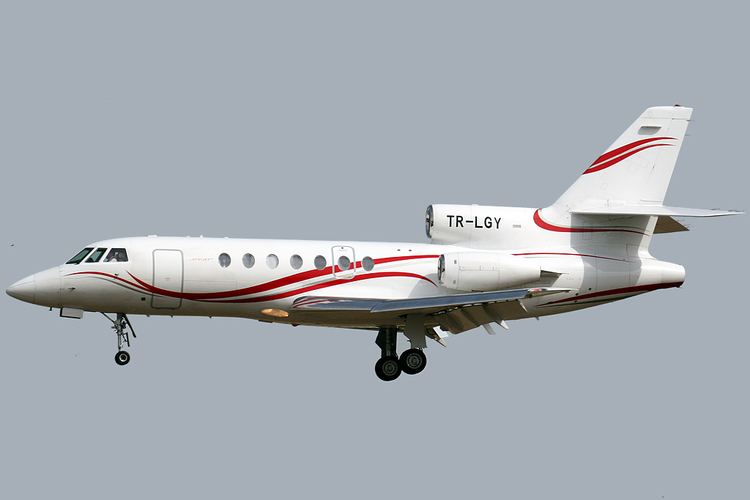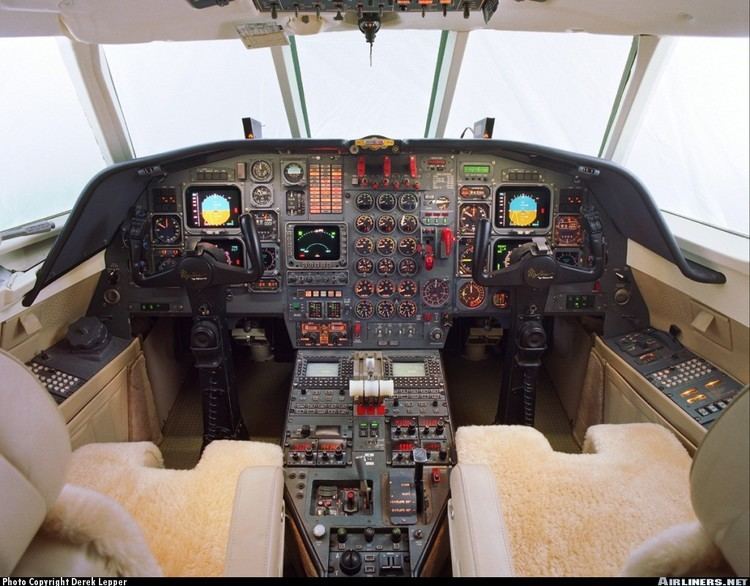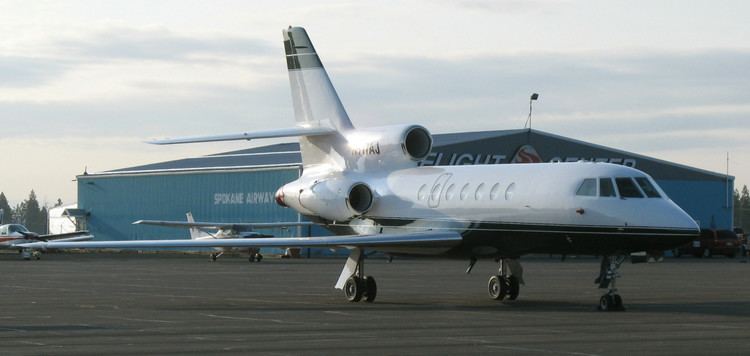Wingspan 19 m Range 6,480 km Cruise speed 888 km/h | Length 19 m Top speed 915 km/h Engine type Garrett TFE731 | |
 | ||
1994 dassault falcon 50
The Dassault Falcon 50 is a French-built super mid-sized, long-range corporate jet, featuring a three jet engine layout with an S-duct central engine. It has the same fuselage cross-section and similar capacity as the earlier Falcon 20 twinjet but is a completely new design that is area ruled and includes a more advanced wing design.
Contents
- 1994 dassault falcon 50
- Dassault falcon 50 taxi and take off at bern airport
- Design and development
- Background
- Modifications
- The attack on USS Stark
- Operators
- Former operators
- Accidents and incidents
- Specifications 50EX
- References

Dassault falcon 50 taxi and take off at bern airport
Design and development

The first prototype flew on 7 November 1976, with French airworthiness certification on 27 February 1979, followed by U.S. Federal Aviation Administration certification on 7 March 1979. Dassault developed a maritime surveillance and environmental protection version as the Gardian 50

The Falcon 50 was later replaced by the Falcon 50EX, the first of which flew in 1996, and the last of which was delivered in 2008. The Falcon 50EX features improved engines and other enhancements to give further range improvements to an already long-legged jet. It remains a very popular corporate jet for its long-range, luxury, and for the recognition of status for owning a fast three-engined jet. The Falcon 50EX designation applies to serial numbers 251, and 253–352, which marks the end of the production line for the Falcon 50/50EX.
The last Falcon 50EX was built in late 2007 and delivered in early 2008.

Successors to the Falcon 50 are the Falcon 7X and the Falcon 900 featuring a larger fuselage and the same three-engine arrangement. Dassault announced in January 2008 what is essentially a replacement aircraft for the Falcon 50, codenamed the "SMS" (Super Mid Size). The basic design process, including engine selection was supposed to be completed by early 2009. However, in a June 2009 press conference, CEO Charles Edelstenne said that all design choices had been reopened and the goal was extended to the end of the year.

Dassault and Aviation Partners Inc. have announced that High Mach blended winglets were being developed for the Falcon 50 as a retrofit kit.
Background

During the Iran–Iraq War several oil tankers had been sunk and in 1986 this led to Iran moving their oil exports to the Sirri Island oil terminal, an island that was out of reach of Iraqi Air Force reconnaissance. The Iraqi air force did operate two Dassault Mirage F1 variants, the F1EQ-4 and F1EQ-5, equipped for inflight refueling that could reach the oil terminal, but was reluctant to use them because that capability was still a secret. Iraqi Intelligence Service operated a Falcon 50 in VIP configuration and offered to install reconnaissance cameras in it, and then fly a clandestine sortie over Sirri Island. It would appear to be one of the many airliners flying along local commercial corridors.
The aircraft had the civil registration YI-ALE and Iraqi Airways markings, taking off from Queen Alia International Airport in Jordan and carrying a crew of two, plus three experienced Mirage pilots. Heading to Mumbai airport in India, the aircraft passed about 30 kilometers west of Sirri island. This was close enough for the crew to take photos using a handheld camera with a powerful optical zoom. They repeated the same procedure on the way back to Jordan the next day. The photographs facilitated a successful attack on the oil terminal on Sirri island with Mirage aircraft.
Modifications
The Iraqi Air Force's Mirage F1EQ-5 was equipped with Exocet missiles but could carry only one. An aircraft that could carry two Exocet missiles and that would not draw attention to itself was desired, the Falcon 50 being considered suitable. The Thales Group was asked to modify the aircraft with the same radar and weapons system as the Mirage F1EQ-5, for alleged pilot training purposes.
The attack on USS Stark
Early on 17 May 1987 a pilot from No. 81 Squadron took off on the first attack mission from Wahda Air Base, 45 km south-west of Basra. At the edge of the Iraqi-declared exclusion zone north of Bahrain a medium-sized naval vessel was identified. The pilot determined that it was about to enter the exclusion zone and attacked the vessel with both Exocet missiles. The Iraqi government apologized and claimed that “The pilot mistook Stark for an Iranian tanker”. The American government accepted the apology and assigned blame to Iran instead. American intelligence was convinced it was a Mirage F1 that had attacked.
Operators
Former operators
Accidents and incidents
Specifications (50EX)
Data from Flight International
General characteristics
Performance
Avionics
Collins ProLine4
